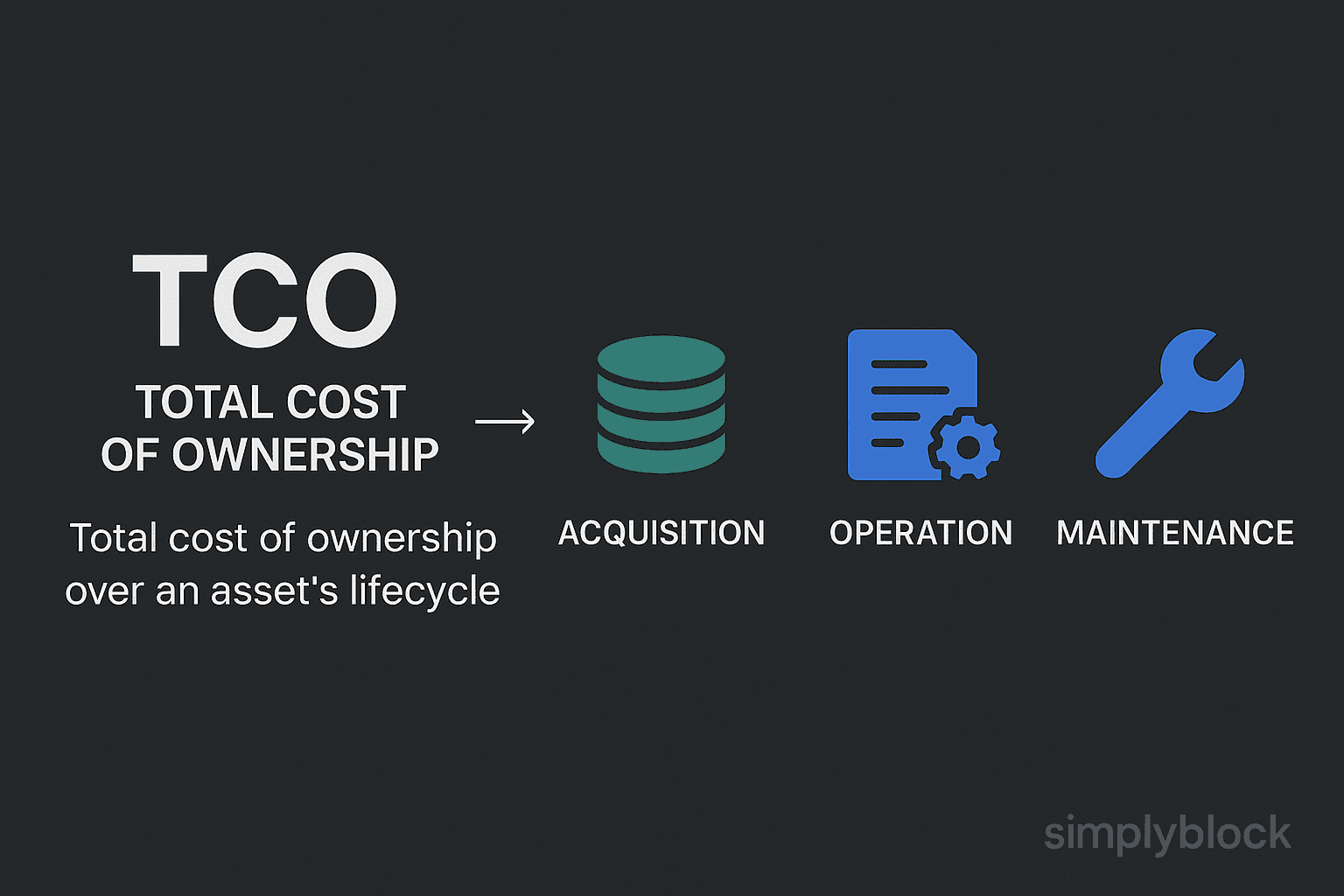TCO
Terms related to simplyblock
TCO (Total Cost of Ownership) is a financial metric that captures the complete cost of acquiring, deploying, maintaining, and retiring an asset or system over its entire lifecycle. In the context of IT and cloud infrastructure, TCO helps decision-makers evaluate the true economic impact of a storage system, cloud service, or software-defined infrastructure, not just its upfront price.
TCO analysis is essential for comparing technologies such as NVMe vs. SATA, on-premises vs. cloud, or monolithic SAN vs. disaggregated storage. It informs long-term planning by accounting for capital expenses (CapEx) and operational expenses (OpEx), enabling organizations to make data-driven investment decisions.
What’s Included in TCO?
A complete TCO evaluation includes both direct and indirect costs across the asset’s usable life. For IT systems, this typically includes:
- Hardware Costs: Servers, storage, network switches, racks.
- Software Licensing: SDS platforms, virtualization tools, monitoring stacks.
- Deployment and Integration: Engineering hours, consulting, configuration.
- Power and Cooling: Energy consumption, cooling infrastructure.
- Maintenance: Support contracts, firmware updates, hardware replacement.
- Staffing: Admin, DevOps, and SRE personnel.
- Training and Certification: Skills development for managing new tech.
- Downtime or SLA Penalties: Lost revenue or credits for failure to meet guarantees.
- Depreciation and End-of-Life Disposal: Final asset retirement and recycling.
Platforms like simplyblock offer TCO advantages by combining performance, scalability, and automation in a single SDS solution, reducing both CapEx and OpEx across hybrid, edge, and Kubernetes-native environments.

Benefits of TCO Analysis
Understanding TCO empowers enterprises to evaluate investments based on long-term value, not just purchase price. Key benefits include:
- Financial Clarity: Highlights hidden operational costs that may outweigh initial savings.
- Better Vendor Comparisons: Allows apples-to-apples evaluation of cloud, on-prem, or hybrid solutions.
- Scalability Forecasting: Helps predict the economic impact of scaling up or out.
- OpEx Reduction: Identifies areas for automation and optimization that lower recurring costs.
- Budget Optimization: Ensures financial planning aligns with IT strategy and business goals.
For example, NVMe-over-TCP may appear costlier upfront than SATA or iSCSI-based SAN, but its TCO is often lower due to reduced latency, higher IOPS per core, and minimal infrastructure complexity, especially when deployed using a scale-out architecture.
TCO vs CapEx vs OpEx
TCO integrates both CapEx (Capital Expenditure) and OpEx (Operating Expenditure), giving a full-spectrum view of the financial lifecycle.
| Metric | Description | Examples |
|---|---|---|
| CapEx | One-time investment to acquire assets | Servers, storage arrays, switches |
| OpEx | Ongoing operational costs | Power, support, staff, cloud fees |
| TCO | Total lifetime cost (CapEx + OpEx + risks) | All of the above + downtime, training |
A lower CapEx solution may have a higher TCO if it incurs high OpEx due to inefficiencies, manual management, or frequent failures.
Use Cases for TCO Analysis
TCO is used across a wide range of IT planning and procurement scenarios:
- Evaluating Cloud vs On-Premises: Estimating ongoing cloud spend vs in-house depreciation and energy.
- Kubernetes Storage Cost Planning: Assessing volume provisioning, replication costs, and scaling.
- Storage Vendor Comparisons: Ceph vs simplyblock or SAN vs NVMe-over-TCP.
- Edge vs Centralized Infrastructure: Calculating remote support and fault recovery costs.
- SLA Penalty Risk Management: Quantifying the cost of service downtime or performance violations.
Simplyblock provides operational simplicity and lower total overhead by integrating telemetry, erasure coding, and smart volume management—all of which reduce the TCO over traditional SAN or legacy SDS systems.
TCO in Simplyblock™
At simplyblock, our platform is built with TCO in mind from day one:
- Commodity Hardware Support: Run on standard x86 servers—no vendor lock-in.
- High IOPS Efficiency: NVMe-over-TCP delivers better performance per CPU core.
- Automation and Observability: Integrated monitoring and volume orchestration reduce staffing needs.
- Multi-Tenant Architecture: QoS policies reduce overprovisioning and resource waste.
- Tiered Storage: Combine SATA, SAS, and NVMe to optimize the cost-performance ratio.
These capabilities translate directly into a lower TCO, helping businesses scale storage efficiently without sacrificing performance or reliability.
Related Topics
How TCO intersects with infrastructure decisions:
- What is CapEx vs OpEx
- Storage Overprovisioning Pitfalls
- Edge & Hybrid Storage Economics
- SDS in Kubernetes
External Resources
- Total Cost of Ownership – Wikipedia
- AWS TCO Calculator
- Microsoft Azure TCO Estimator
- IDC: Measuring the Business Value of SDS
Questions and Answers
TCO (Total Cost of Ownership) includes all direct and indirect costs of a storage solution over its lifecycle—hardware, software, operations, maintenance, and energy. It’s a critical metric when comparing on-prem vs. cloud or evaluating software-defined storage platforms.
NVMe over TCP reduces TCO by enabling high-performance storage over standard Ethernet, eliminating the need for expensive Fibre Channel infrastructure. It improves scalability and resource utilization while lowering hardware and operational costs.
Kubernetes-native storage automates provisioning, reduces complexity, and optimizes resource usage. By avoiding over provisioning and streamlining management, it cuts both CapEx and OpEx, leading to a more efficient cost structure.
Encryption at rest adds a small performance and management overhead but helps avoid costly compliance violations or security breaches. Built-in volume-level encryption can reduce the need for third-party tools, improving overall TCO.
To calculate TCO, include hardware, software licensing, support contracts, personnel time, energy usage, and expected upgrades over time. Modern, disaggregated approaches like Simplyblock’s NVMe-based storage often offer lower TCO compared to legacy SAN/NAS solutions.
